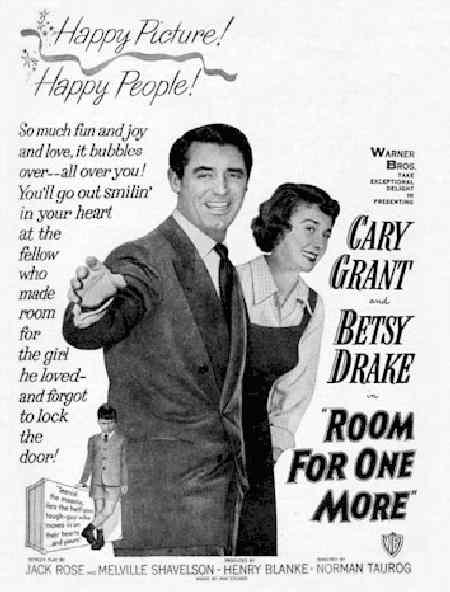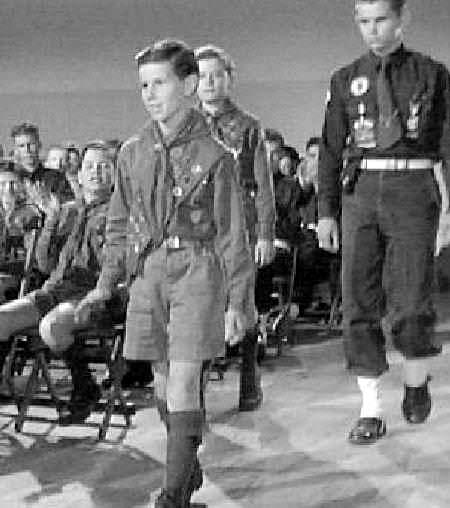
Figure 1.--The poster features the two stars, Cary Grant and his wife Betsy Drake. Note George "Foghorn" Wilson in the corner dressed in an Eton suit.


Figure 1.--The poster features the two stars, Cary Grant and his wife Betsy Drake. Note George "Foghorn" Wilson in the corner dressed in an Eton suit. |
This was George "Froghorn" Winslow's first film and it starred Cary Grant
and Betsy Drake as parents of a family which included their own children and several adopted children. Betsy Drake played a child psychologist who combined love and discipline beautifully as a mom. Cary Grant as dad was not always so sure of his wife's theories, but he always consented to her wishes with good humor. They have three kids of their own generously open their home to two foster children. This was George "Foghorn" Winslow's first film. He was about 5 and recommended by Cary Grant who stared in the film about a couple that can't resist adopting hard to place children. It is one of the better-costumed American films.
This Warner Brothers film was based on a popular book of the early 1950s written by Anna Perott Rose. The film was directed by Norman Taurog and produced by Henry Blanke.
This is Grant's 57th film and his second with Betsy Drake. Grant plays "Poppy" Rose and Drake plays his wife, Anna. This was George "Froghorn" Winslow's first film and it starred Cary Grant and Betsy Drake as parents of a family which included their own children and several adopted children. Betsy Drake played a child psychologist who combined love and discipline beautifully as a mom. This was George "Foghorn" Winslow's first film. He was about 5 and recommended by Cary Grant who stared in the film. Grant is solicitous with the children -- if never quite comfortable. This is a much more domestic role than Grant is usually cast. But he is very effective and the relationship with the children rather hart warming. The cast not to mention the stray animals interact very well on screen. George's supporting role is particularly effective.
The Rose home is a happy place. "Poppy" (Cary Grant) tries hard to make ends meet for his wife and three kids. His wife collects unwanted and problem children and pets. Her long-suffering husband appeased her as best he can. They end up adopting another two (difficult) children. Cary Grant as dad was not always so sure of his wife's theories, but he always consented to her wishes with good humor. They have three kids of their own generously open their home to two foster children. The plot deals with a couple, actually a mother, that can't resist adopting hard to place children. It is one of the better-costumed American films. The family has three children, including two boys. George plays "Teeny" beautifully with his astute dead-pan seriousness. The family takes in an obnoxious girl. The next foster child is a boy, who is about 12. He is aflicted with polio. The storyline includes the problems (and their resolution) of each of the adopted children, but this boy's difficulties received more film time. Like the girl he is obnoxious. In one scene after a little smacking, he takes off all his clothes and takes off down the street. As it is an American film, it is all very discrete. He eventually fits in nicely and becomes a model boy and scout.

Figure 2.--The former problem child is shown here becoming an Eagle Scout. The boy to the right is an Explorer Scout. |
Teeny (George) wears shorts short pants throughout, even in the dead of winter. He has a little boy suit with a collarless Eton-type jacket. He doesn't wear knee socks. He has an older brother who is 11 or 12 and appears several times in a short pants scout uniform, even in the winter scenes! On two occasions he appears with many other short panted scouts. He also appears in play shorts, but interestingly his chums are all wearing longs. His dress suit, however, has longs. The newly adopted boy appears in play shorts and then in a Scout uniform. He even goes on a long winter hike all bundled up in a winter jacket, but in shorts! When he gets his new suit, he shows it off proudly, says "longies just like Popi's." None of the older boys wear short pants suits. The older of Cary and Betsy's two sons is an active Boy Scout (played by Patrick Curtis). The newly adopted younger boy featured in the film is partially disabled. He has to wear a caliper/leg brace and finds this very frustrating, making him a difficult foster child. This boy joins the troop, eventually becoming an eagle scout. He overcomes his disability to excell as a scout. He is pictured at an award ceremony, watched by proud foster parents Cary Grant and Betsy Drake. His determination to overcome his affliction and be one of the troop are quite moving, and his eagle scout award ceremony really touches the heart. The scouts wear both long and short trousers uniforms in the film. They may have been a bit ahead of their time in opting for the shorts uniform at one of the troop meetings and the award ceremony. The boys wear T shirts and shorts and a high topped sneakers on vacation, but otherwise sports shirts and long trousers typical of the early 1950's. Curriously if I remember correctly, the handicapped boy goes on a long hike in the dead of winter in the short pants uniform. At a dance party, the boys wore long trousers suits and ties. In much of the film the boys wear long sleeved sports shirts and long trousers, and lace-up shoes, typical of the early 50's in the U.S.
This is a funny and rather effective film about foster care. As is the case of pre-1960s American films, the sentiment can be rather sacrinine at times. A rich slice of sentimental folksy Americana! As one HBC reader phrases it, "It's one of my favorites, mainly because of it's corny happiness."
While "Room for One More" is the most widely used title. HBC has noted that this film is also called "The Wasy Way". I think it was distributed under this title in Britain.
Navigate the Boys' Historical Clothing Web Site:
[Return to the Main "Rm-Rz" movie page]
[Return to the Main alphabetical movie page]
[Return to the Main Scout movie page]
[Introduction]
[Activities]
[Biographies]
[Bibliographies]
[Chronology]
[Clothing styles]
[Countries]
[Contributions]
[FAQs]
[Glossaries]
[Boys' Clothing Home]
